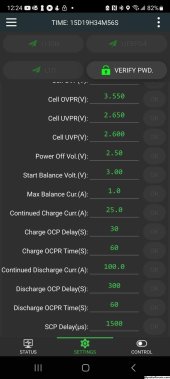byteharmony
Sunny side up please.
Looking at putting together a multiple battery system today and was planning on following the advice of using a Class T fuse to protect the different batteries in parallel from each other.
The market seems to be offering those fuses form 100 Amps to 300 Amps. $20 - $100
I'm considering 2 different BMS units, a 100 AMP $80 and a 40 AMP $40.
The cells connected can easily push 150 amps.
My load could easily be limited to 30 AMPS.
If I go 100 AMP BMS $80+ 100 AMP fuse $50 = $150
If I go 40 AMP BMS $40 and that's it, the BMS may fry, it should not, it should stop an over draw, and then I'm only out $40 (and a rewire .
.
Wondering if anyone has any experience with choosing the $40 40 AMP jkbms and depending on it to cut the current if it spikes?
I get that it could fry your inverter, but the inverter is limiting draw to 60 AMPS and the other battery is limited to 100 AMPS with DC breakers (Trophy).
In case you're wondering the goal, it's to extend the capacity of a single 100 Ah trophy 48v battery with multiple smaller batteries.
The market seems to be offering those fuses form 100 Amps to 300 Amps. $20 - $100
I'm considering 2 different BMS units, a 100 AMP $80 and a 40 AMP $40.
The cells connected can easily push 150 amps.
My load could easily be limited to 30 AMPS.
If I go 100 AMP BMS $80+ 100 AMP fuse $50 = $150
If I go 40 AMP BMS $40 and that's it, the BMS may fry, it should not, it should stop an over draw, and then I'm only out $40 (and a rewire
Wondering if anyone has any experience with choosing the $40 40 AMP jkbms and depending on it to cut the current if it spikes?
I get that it could fry your inverter, but the inverter is limiting draw to 60 AMPS and the other battery is limited to 100 AMPS with DC breakers (Trophy).
In case you're wondering the goal, it's to extend the capacity of a single 100 Ah trophy 48v battery with multiple smaller batteries.



